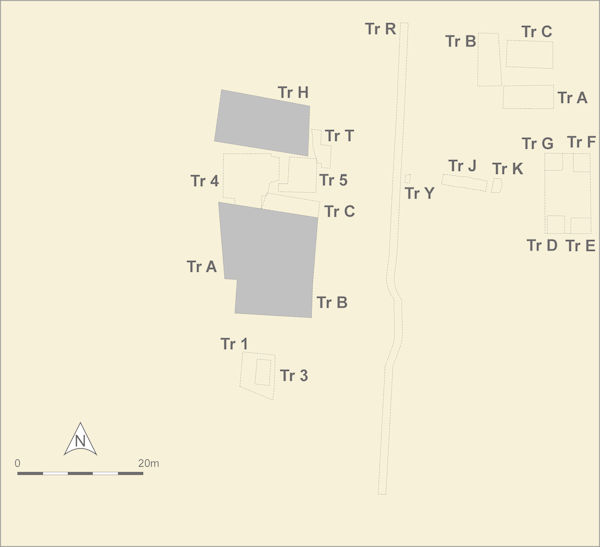

During this phase a clay surface was laid to the east of Trenches A and B and two post-holes adjacent to this surface may have been the remains of a building associated with this floor. Two ditches and two pits towards the south of the excavated area were also in use at this time. This phase appears to represent the preparation of the area for the construction of the friary and may have taken place shortly prior to or around the year 1273.
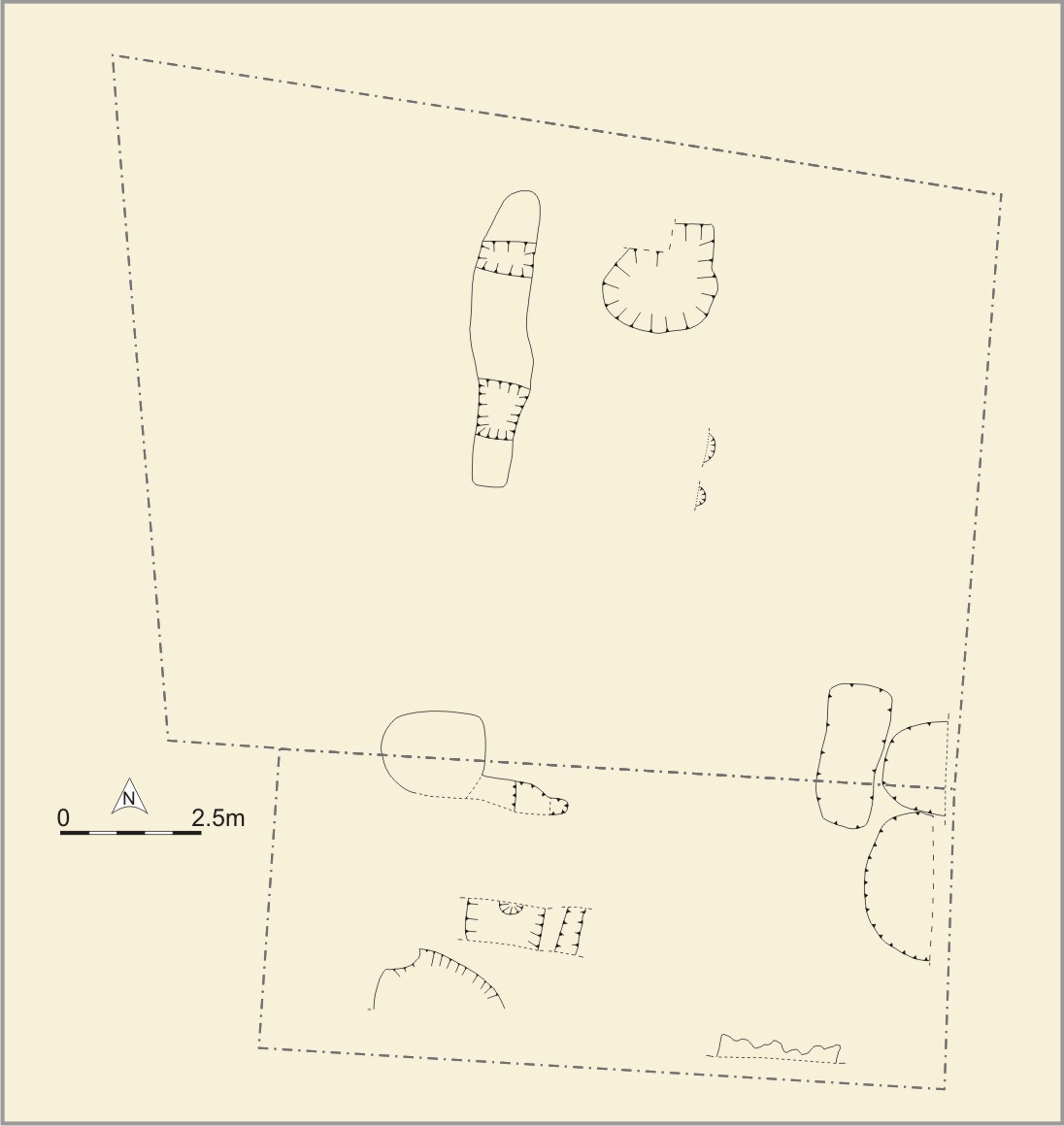
Two post-holes (ACP and ACQ) may be the remains of a structure (Structure 1). Their fills were black loam, possibly the remains of the wooden posts they had once contained.
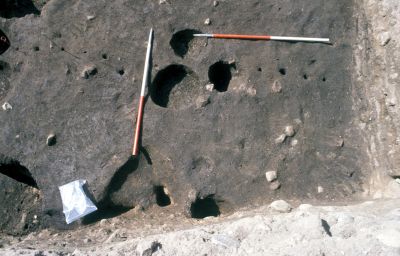
The remains of the first definite structure was a series of two or three lines of stake-holes [Photo 0547] (AQX-ARI) which had been cut through the Phase 1b plough soil. These stake-holes (Structure 2) were 3-5cm diameter and 5-23cm deep and were filled with brown loam, probably the remains of the wooden stakes that they had held. There is no evidence that larger posts were used in this building, and therefore the small diameter of the stake suggests that this structure was insubstantial: either temporary in nature or a low unroofed enclosure.
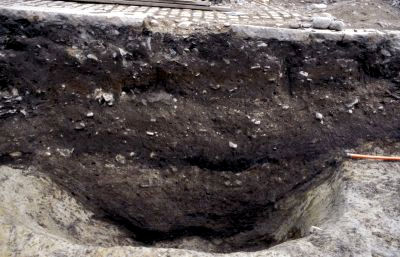
A series of sub-circular pits in the south of the excavation area (AGE, AHS, AHD [Photo 0263] and AGF were filled with silt, charcoal and stones. Context A393 in pit AHD included wheat or rye bran, rowan and crowberry, all indicators of food waste as well as a lot of Sphagnum moss, commonly used as toilet 'tissue' (Section 9.3). Weed seeds likely to have been from cornfields and a moderate number of seeds of waste places and cultivated land suggest that part of the fill was made up with waste from the cultivation and milling for the production of flour. The layer also contained Trichuris eggs, suggesting that a minor component of the layer was faecal matter, as well as evidence of stable manure (Section 9.3). AHD may have been dug as a cess or rubbish pit, or dug to extract sand and gravel and then filled with cess, milling waste and other rubbish. Pit AHD contained a copper alloy lace chape (id 884) and wire fragment (id 885) and extraction pit AHG contained a copper alloy brooch (id 878). The fill of pit AHD suggests that people were living and working in this area during this period, although this may relate to activity east of the site under what is now Martin's Lane and the west side of Carmelite Street. The copper alloy finds, however, suggest that it may relate to the early phase of Carmelite occupation of the site.
AFH was a shallow 'cut' at the south end of the excavation area which was partly excavated. Its uneven edges make it difficult to interpret although it may have been another extraction pit.
At an early stage in the development of this site, prior to the construction of the buildings, a programme of drainage took place. This was probably as a direct result of the waterlogged nature of the site as evidenced by the Phase 1 water channels running over much of the site. This management took the form of the digging of ditches and a possible 'sump' ABI. Substantial ditch (ABP) was U-shaped in section and was filled with clean compact silty clay. It was not possible to excavate the bottom of this feature (as it was below the water table and was acting as a collection point for water during the excavation) and therefore it is not possible to determine whether the ditch was open for any length of time.
The possible 'sump' (ABI) was a large pit filled with mixed clays and loams including layer A61 which contained peat and charcoal fragments (Section 9.3). During the excavation the bottom of this feature was continually filled with water and it was, therefore, not possible to excavate its lower layers. It contained a small number of finds, including a fragment of window glass, which may be intrusive. One interpretation of this feature is that it was dug as a 'sump' through the clays which formed the subsoil on the site and through to the natural gravels underneath. This would have drained water away from on top of the clays. The excavated layers indicate that it was subsequently filled with clays and loams which contained fragments of pottery and floor tiles. An alternative explanation is that it was dug to extract sand or clay for use as building materials.
Ditches AHO and AHL had been filled with mixed clays and charcoal; no silt layers were present which suggests that the ditches were not left open for any period of time. Small pit, AHP, was set into the bottom of AHO, and may have been dug to sink a post. This evidence, along with the fact that the ditch was open for only a short period of time, may suggest that AHO was dug on a boundary to support a post-and-wattle fence.
Pit AOD [Photo 0407] was contemporary with this phase but its purpose has not been established. It does not seem to be associated with Structure 2.
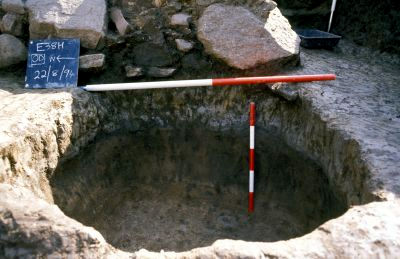
Internet Archaeology is an open access journal based in the Department of Archaeology, University of York. Except where otherwise noted, content from this work may be used under the terms of the Creative Commons Attribution 3.0 (CC BY) Unported licence, which permits unrestricted use, distribution, and reproduction in any medium, provided that attribution to the author(s), the title of the work, the Internet Archaeology journal and the relevant URL/DOI are given.
Terms and Conditions | Legal Statements | Privacy Policy | Cookies Policy | Citing Internet Archaeology
Internet Archaeology content is preserved for the long term with the Archaeology Data Service. Help sustain and support open access publication by donating to our Open Access Archaeology Fund.